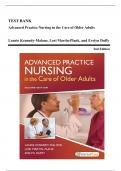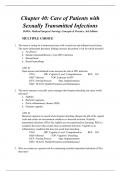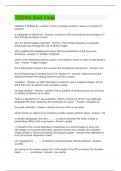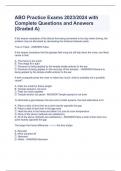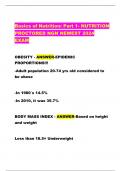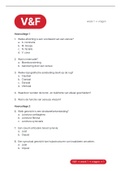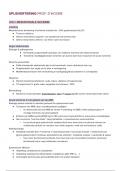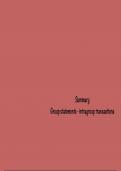TEST BANK
Advanced Practice Nursing in the Care of Older Adults
Laurie Kennedy-Malone, Lori Martin-Plank, and Evelyn Duffy
2nd Edition
,Table of Contents
Chapter 01 Changes With Aging 1
Chapter 02 Health Promotion 8
Chapter 03 Exercise in Older Adults 16
Chapter 04 Comprehensive Geriatric Assessment 24
Chapter 05 Symptoms and Syndromes 31
Chapter 06 Skin and Lymphatic Disorders 39
Chapter 07 Head, Neck, and Face Disorders 47
Chapter 08 Chest Disorders 56
Chapter 09 Peripheral Vascular Disorders 64
Chapter 10 Abdominal Disorders 72
Chapter 11 Urological and Gynecological Disorders 81
Chapter 12 Musculoskeletal Disorders 88
Chapter 13 Central and Peripheral Nervous System Disorders 96
Chapter 14 Endocrine, Metabolic, and Nutritional Disorders 104
Chapter 15 Hematological and Immune System Disorders 113
Chapter 16 Psychosocial Disorders 120
Chapter 17 Polypharmacy 128
Chapter 18 Chronic Illness and the APRN 136
Chapter 19 Palliative Care and End-of-Life Care 145
,______________________________________________________________________________________________
Test Bank - Advanced Practice Nursing in the Care of Older Adults, 2nd Edition (Kennedy-Malone, 2019)
Chapter 1: Changes With Aging
MULTIPLE CHOICE
1. Mrs. Smith, 75 years old, reports that she is weak, has difficulty urinating, and is
dehydrated. Although she is afebrile, the nurse conducts a thorough physical examination,
including urinalysis and complete blood count (CBC). The total assessment is necessary
because:
a. All body systems interact, and symptoms could indicate a variety of diagnoses.
b. The symptoms are vague and may be signs of aging.
c. There may be other signs or symptoms more indicative of the condition.
d. Mrs. Smith may not be reporting all significant information.
ANS: A
Feedback
A The clinician must be aware that all the systems interact and, in doing so, can
increase the older person’s vulnerability to illness/disease.
B The nurse must not attribute symptoms only to the aging process.
C There may be comorbidities accompanying this condition.
D Assumptions of not reporting properly may not be true.
REF: Page: 2
2. A patient with renal disease has blood work drawn, and the results show an increase in
serum creatinine. The nurse practitioner needs to know which of the following laboratory
values before ordering medications?
a. CBC
b. Culture and sensitivity of the urine
c. Creatinine clearance
d. Uric acid levels
ANS: C
Feedback
A A CBC will not evaluate kidney function for a patient with renal disease.
B A culture and sensitivity test reflects the presence of an infection and the
antibiotic to which the organism is sensitive.
C The calculation of creatinine clearance provides an estimation of renal function.
D Uric acid level is elevated in the presence of gout.
REF: Page: 3
3. Which of the following statements is true regarding diagnostic testing?
a. A test is ordered for a specific purpose.
b. A test is the most invasive available.
c. There is no need to discuss results with the patient.
d. If a test is needed, it should be ordered regardless of risk to the patient.
______________________________________________________________________________________________
1|Page
,______________________________________________________________________________________________
Test Bank - Advanced Practice Nursing in the Care of Older Adults, 2nd Edition (Kennedy-Malone, 2019)
ANS: A
Feedback
A The nurse practitioner should have a plan for the use of each test result value
obtained.
B When considering which laboratory tests to order, it is worth remembering the
doctrine primum no nnocere—first, do no harm.
C Once laboratory tests are available for review, tests results should be discussed
with the patient, with abnormal test results interpreted for the aging individual
and addressed with the patient and caregivers.
D Any risks involved in laboratory testing must be considered concerning the
patient’s clinical condition and weighed against the test’s expected benefits.
REF: Page: 3
4. Janey, 25 years old, may experience arthritis differently than 65-year-old Mrs. Johnson
because:
a. The body undergoes physiological changes with aging.
b. A healthy body does not experience significant changes as one gets older.
c. Older patients do not feel any systemic symptoms, such as malaise and weight
loss.
d. Even though the same joints are usually affected, age makes it feel different.
ANS: A
Feedback
A Knowledge of the bimodality of age onset of certain disease conditions will aid
the advanced practice nurse in avoiding misdiagnosis or delay in diagnosis due
to lack of recognition.
B Symptoms of rheumatoid arthritis may be different depending on the age of the
patient.
C Younger patients may not experience constitutional symptoms such as fever,
malaise, weight loss, and depression.
D In late-onset rheumatoid arthritis, the joint involvement is more often in the
larger joints.
REF: Page: 5
5. The nurse practitioner is examining an 85-year-old man with reports of abdominal pain,
weakness, and loss of appetite. Which is the most likely condition to be tested for and ruled
out?
a. Neoplasms and carcinomas
b. Partial seizure
c. Sarcopenia
d. Hirschsprung’s disease
ANS: A
Feedback
A Certain diseases, such as neoplasms and carcinomas, are more common in the
______________________________________________________________________________________________
2|Page
,______________________________________________________________________________________________
Test Bank - Advanced Practice Nursing in the Care of Older Adults, 2nd Edition (Kennedy-Malone, 2019)
elderly, and an understanding of the epidemiology is critical in the interpretation.
B Partial seizure is more common in early old age.
C Sarcopenia is more common in early old age.
D Hirschsprung’s disease is most common in infancy.
REF: Page: 4
6. For individuals over 65 years old, the most common morbidities are related to:
a. Heart disease, arthritis
b. Respiratory problems, cancer
c. Diabetes, stroke
d. All of these are common morbidities.
ANS: D
Feedback
A Heart disease is one of the common morbidities.
B Cancer is common in the general population; however, specific types are more
common in the older patient.
C Diabetes is common in patients over 40 years of age.
D Heart disease, cancer, and diabetes combined are the most common morbidities
in older patients.
REF: Page: 5
7. A gerontological patient is being examined for a report of pain in the shoulder. The nurse
practitioner completes a thorough systemic examination because:
a. Older patients with one morbidity often express difficulties in general.
b. Arthritis of the shoulder is accompanied by other neurological symptoms.
c. Older patients with arthritis often experience pain in lower extremities.
d. The patient may not report significant signs and symptoms.
ANS: A
Feedback
A Older patients with late-onset rheumatoid arthritis experience joint involvement
more often in the larger joints, such as the shoulder, and they also experience
systemic symptoms such as fever, malaise, weight loss, and depression.
B Older patients may express symptoms in any other physical systems.
C Patients more often experience arthritis in smaller joints.
D A thorough examination will detect objective indicators.
REF: Page: 5
8. The nurse practitioner performs a thorough systemic examination of a patient who reports
diarrhea and pain in the upper left quadrant of the abdomen. One possible diagnosis would
be:
a. Hirschsprung’s disease
b. Pancreatitis
______________________________________________________________________________________________
3|Page
,______________________________________________________________________________________________
Test Bank - Advanced Practice Nursing in the Care of Older Adults, 2nd Edition (Kennedy-Malone, 2019)
c. Appendicitis
d. Gastrointestinal inflammatory bowel disease (GIBD)
ANS: D
Feedback
A Hirschsprung’s disease is an obstruction of the colon in infancy.
B Diarrhea is not associated with pancreatitis.
C Appendicitis is more common in younger patients than in older patients.
D GIBD is manifested differently in a bimodal pattern.
REF: Page: 5
MULTIPLE RESPONSE
9. A 70-year-old man is seeing a nurse practitioner because he is feeling weak and dizzy. The
nurse practitioner is discussing a care plan with him and makes which of the following
statements? Select all that apply.
a. I want to order a test for your heart to evaluate its function.
b. I will perform a thorough examination of your functional abilities.
c. I will order a blood sugar test to check for diabetes.
d. Many older people feel this way. It is to be expected.
e. I will assess you for the presence of other conditions.
ANS: A, B, C, E
Feedback
A A complete assessment will help differentiate signs of aging from disease.
B All systems interact and can affect an existing condition.
C Identifying underlying conditions will avoid undertreatment.
D Attributing symptoms to aging can contribute to depression in an older person.
E There are changes in the sympathetic response which contribute to the
orthostasis and falls, as well as lack of hypoglycemic response.
REF: Page: 2, 3
10. The nurse practitioner is leading a class of seniors over age 65 years and is teaching about
nutritional needs. One of the men asks why, even though he eats correctly according to the
standards presented, he still feels weaker than he did 10 years ago. He also wonders why he
gets more infections than he used to. Which of the following are helpful answers? Select all
that apply.
a. I suggest that you exercise a little more than you are currently doing.
b. Some people experience a decrease in reserve energy.
c. For some people, the immune system weakens.
d. More viruses are being spread throughout the community.
e. I suggest that you see your primary caregiver for extensive testing.
ANS: B, C, E
______________________________________________________________________________________________
4|Page
,______________________________________________________________________________________________
Test Bank - Advanced Practice Nursing in the Care of Older Adults, 2nd Edition (Kennedy-Malone, 2019)
Feedback
A Improved nutrition may not be the factor affecting health of elders.
B Many factors can influence the health of elders, including lifestyle and
medications.
C Many factors can influence the health of elders, including changes in the
immune system.
D Viruses and other infections are not the only considerations for infections.
E Biochemical individuality is important in detecting asymptomatic
abnormalities in older adults. Significant homeostatic disturbances in the same
individual may be detected through serial laboratory tests, even though all
individual test results may lie within normal limits of the reference interval for
the entire group.
REF: Page: 2, 3
11. An older woman is seen in the ambulatory clinic for a routine checkup. The patient asks
about results of her blood work compared to last year’s results. How is it best for the
clinician to respond? Select all that apply.
a. They are likely to be the same if you have had no diseases since then.
b. Blood work results may be different just because of your aging process.
c. Your results may be different because the body changes with disease and
medications you are taking.
d. Blood work is not a reliable indicator of health because many things can affect
your health that may not show up in the results of your blood work.
e. There is likely no significant difference as your body remains stable in its
functioning.
ANS: B, C
Feedback
A Biochemical individuality variation is often much smaller than variation within
the larger group.
B The aging process and decline in organ function may affect the health of elders.
C Disease, nutrition, and medications affect the health of elders.
D Although abnormal laboratory findings are often attributed to old age, rarely are
they true aging changes.
E Many factors can influence laboratory value interpretation in the elderly,
including the physiological changes with aging, the prevalence of chronic
disease, changes in nutritional and fluid intake, lifestyle (including activity), and
the medications that are taken.
REF: Page: 4, 5
12. An elderly couple is discussing health concerns with the nurse practitioner. The couple is
concerned that each of their individual blood studies show different results. One set of test
results shows a significant decrease in blood sugar, but the test results of the partner does
not show an equal decrease. Their physician does not seem concerned, and the couple is
wondering why. How is it best for the nurse practitioner to respond? Select all that apply.
a. Studies show that each person’s pattern of chemical make-up is different.
______________________________________________________________________________________________
5|Page
, ______________________________________________________________________________________________
Test Bank - Advanced Practice Nursing in the Care of Older Adults, 2nd Edition (Kennedy-Malone, 2019)
b. There is no difference between one person’s range of blood results and that of any
other person.
c. Each person’s chemical make-up is the same as that of others of the same gender
and age group.
d. Many factors affect an individual’s chemical make-up.
e. Ranges of the values provided by the laboratory are correct for any age.
ANS: A, D
Feedback
A Individuals experience smaller variations in laboratory work than from the
others in the same age group.
B There are wider variations of laboratory results within a group of older people.
C Laboratory values are determined by more than age and gender.
D Laboratory values may vary as a result of nutrition, activity, and emotional
status.
E The reference values presented for the older adult cohort are not necessarily
correct for the individual due to biochemical individuality.
REF: Page: 2, 3
13. Adam, 70 years old, is admitted for possible myasthenia gravis (MG). The nurse practitioner
knows that MG is commonly seen in women between 20 and 40 years old. Adam, however,
is experiencing an ocular form of MG, has dysphonia, and does not have any thymus
abnormalities. Adam asks why the nurse is concerned about MG since he is older and this is
a “young person’s disease.” Which of the following are the best answers? Select all that
apply.
a. We need to assess for anything, just in case.
b. Some diseases show up in two different age and gender groups.
c. Older people often experience weakness, and we must rule out other conditions.
d. Your insurance will cover this, and we want to rule out as much as possible.
e. Signs and symptoms of illness are the same for each disease regardless of age.
ANS: B, C
Feedback
A Ordering more tests than needed violates the principle of “Do no harm.”
B MG is bimodal and can be found in younger women, as well as in both men
and women.
C Knowledge of the bimodality of age onset of certain disease conditions will aid
the nurse practitioner in avoiding misdiagnosis or delay in diagnosis due to lack
of recognition.
D There should be a need for ordering a test and value attributed to the results.
E The manifestations of illness and disease in the elderly can be very different,
even if the underlying pathological process is the same as in younger
individuals.
REF: Page: 5
______________________________________________________________________________________________
6|Page

